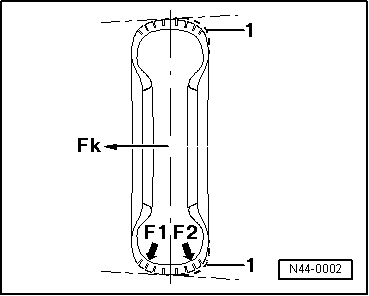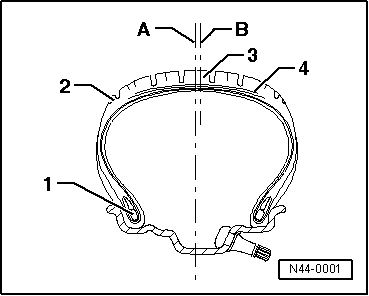| 1 - | Plies and tread surface offset |
| The offset produces differences in stiffness at the inner and outer shoulders of the tyre, resulting in differing forces on the contact patch. Consequently the belt or tread will not be pressed onto the road surface with the same force (F1, F2). A slightly tapered overall shape develops. The resulting force (conicity force Fk) can, depending on the speed, become so great that the vehicle then pulls to one side. |
| If the force Fk on one wheel of the axle is, for example, 50 Newton, and also 50 Newton on the other wheel, and both forces are exerted in the same direction, the forces are cumulated. Reversing a tyre on the rim can compensate for the lateral pull because the forces then act in opposite directions. |
| As the direction in which the conicity force acts is not visible, only road tests and strategic rotation of wheels and tyres will establish which tyre is causing the tendency to pull to one side. |
| The tyre consists of numerous components and materials which are vulcanised to form a single part at the end of a complicated manufacturing process. This results in differing production tolerances which can cause more or less noticeable lateral forces (lateral forces resulting from the tapered shape). These forces can also occur in new tyres. |
| Pulling to one side on front axle: |
| Pulling to one side can be caused by the running gear. However, experience shows that in 90% of all complaints, the tyres cause pulling to one side. |
| Pulling to one side during normal driving: |
| On a straight, level road surface, the vehicle wants to pull to one side at a constant speed or with moderate acceleration. Force can be felt at the steering wheel. |
| Pulling to one side during fast acceleration: |
| Pulling to one side during fast acceleration is, in part, due to the basic design of vehicles with front wheel drive. Different friction levels at the left and right wheels or possible irregularities in the road surface (potholes) and consequently varying road adhesion have a substantial influence on the handling characteristics. This does not constitute a complaint which is covered by the warranty. |
|
|

|



